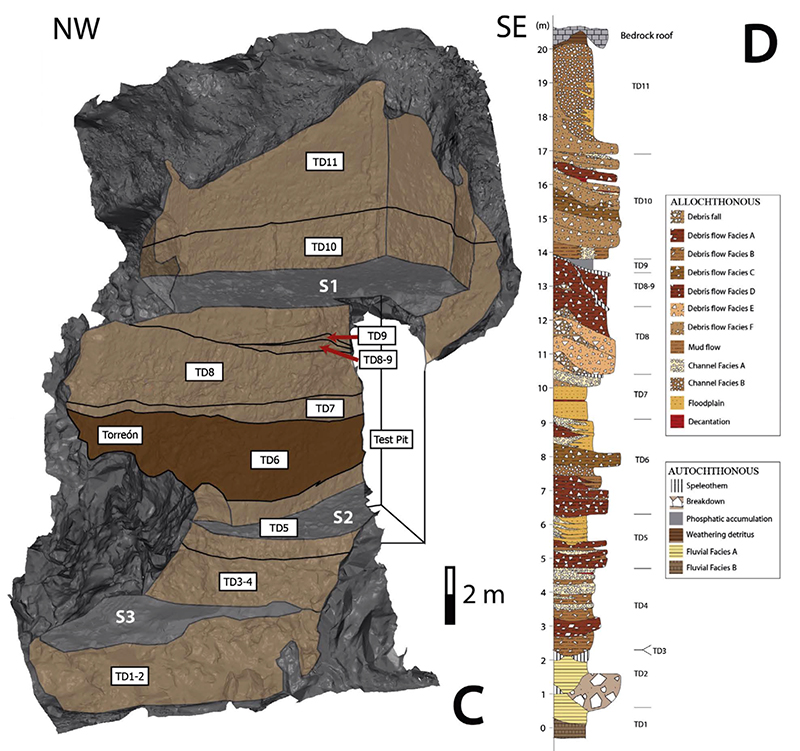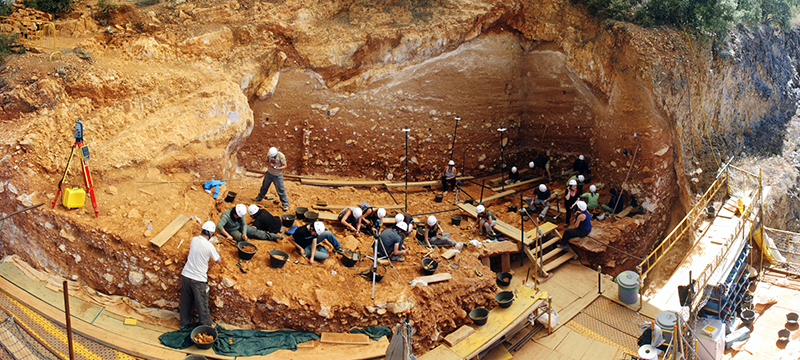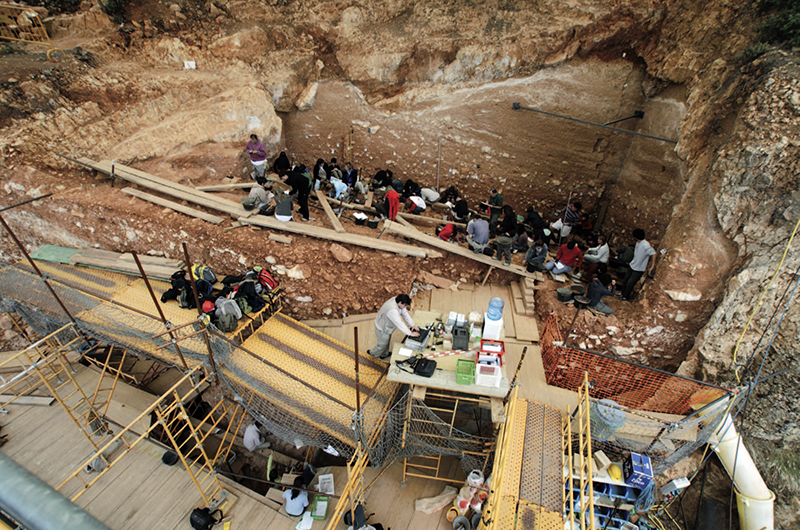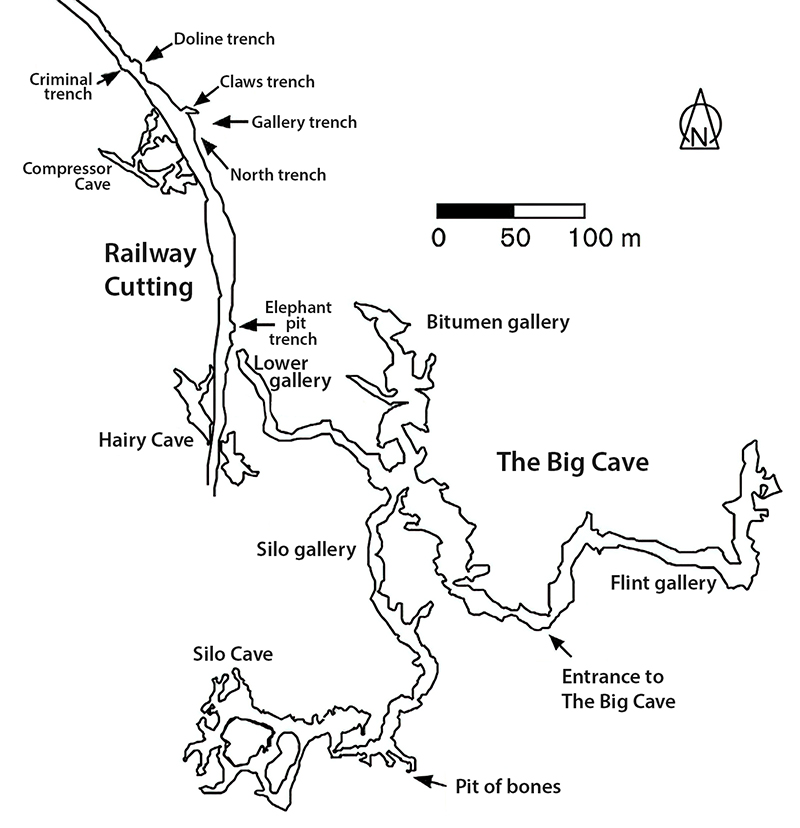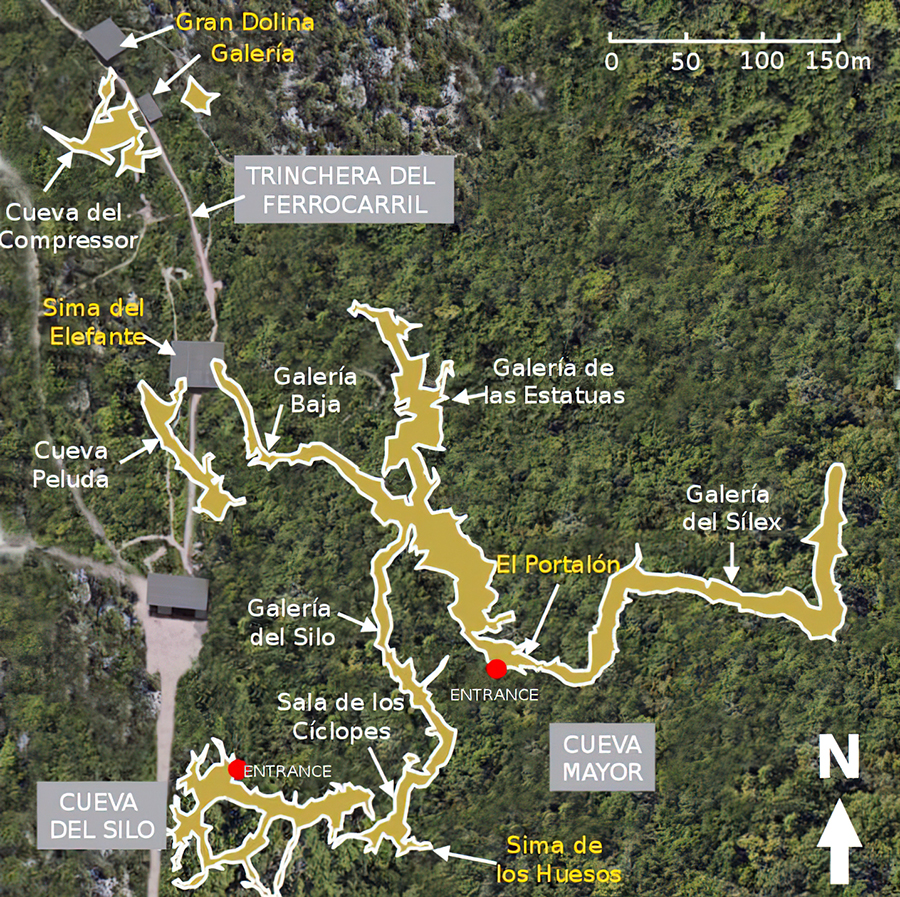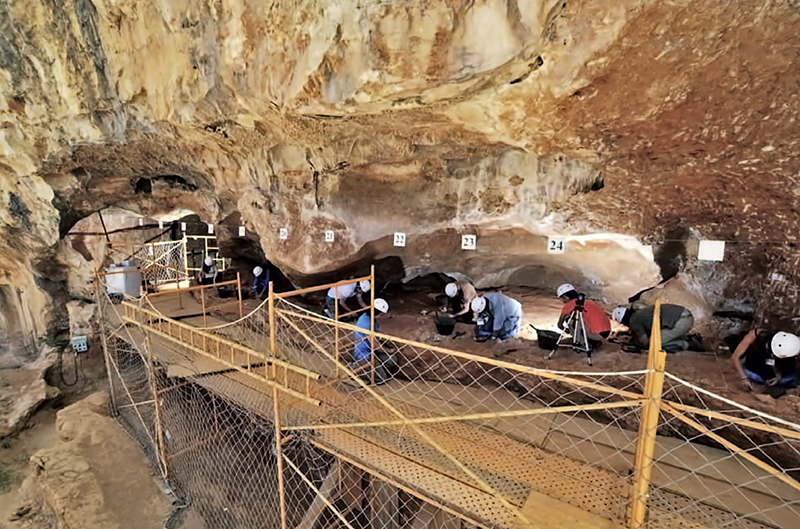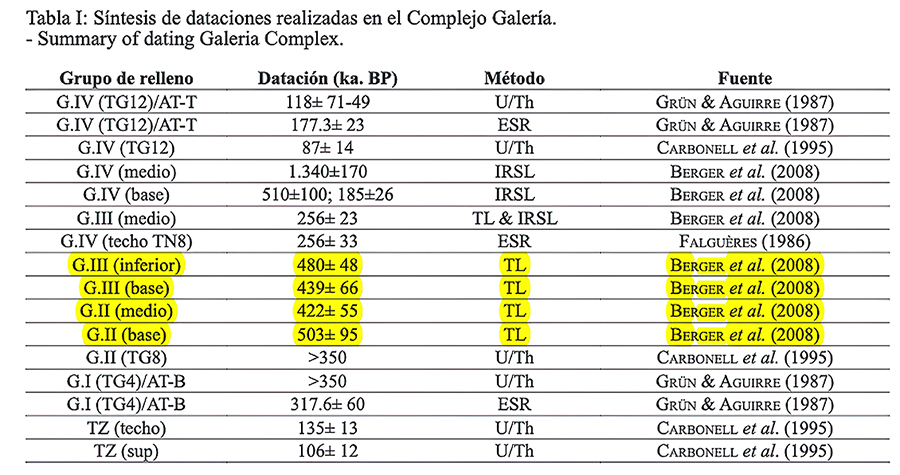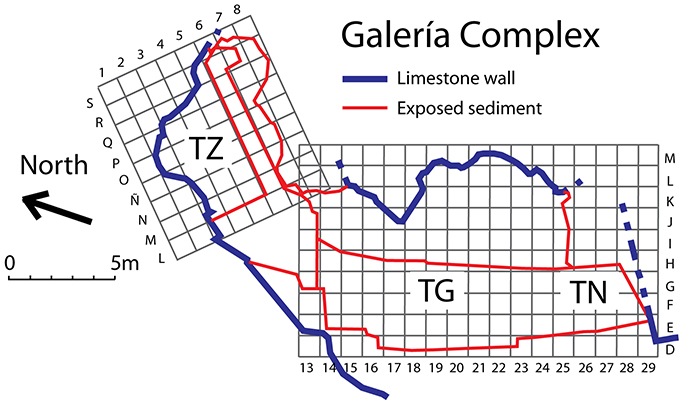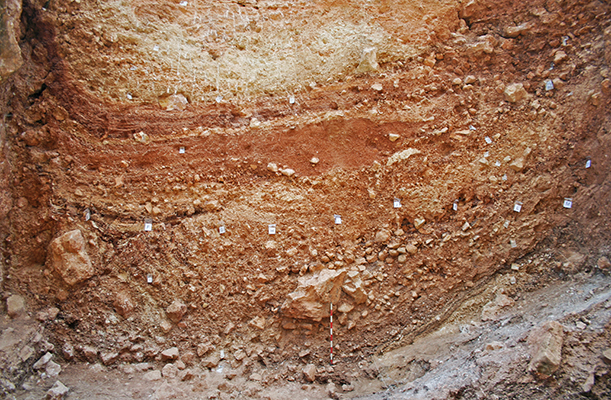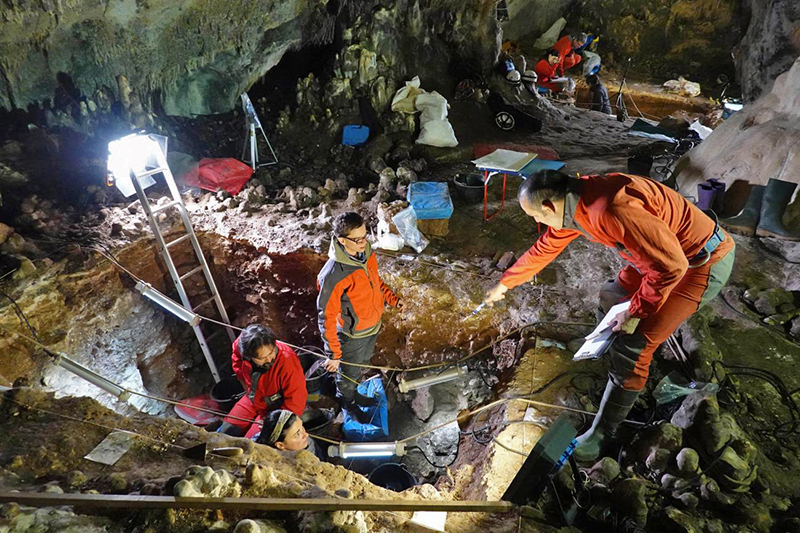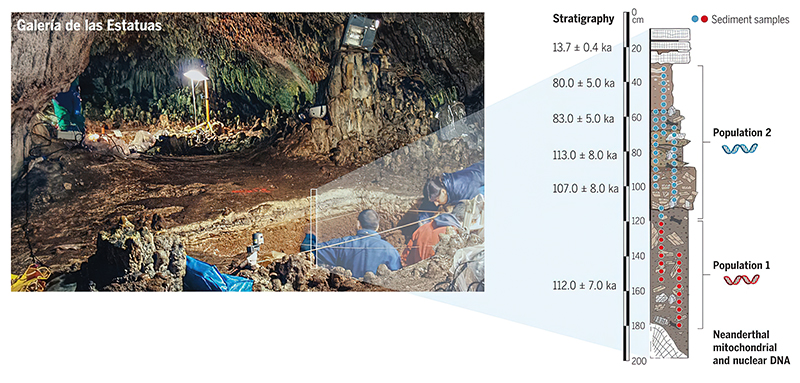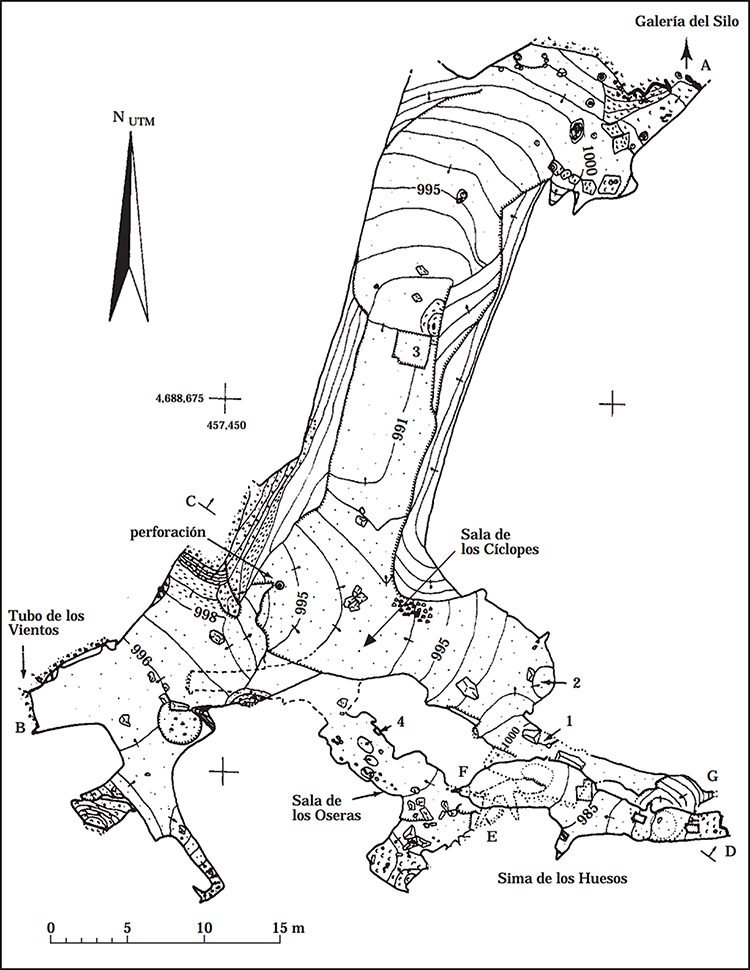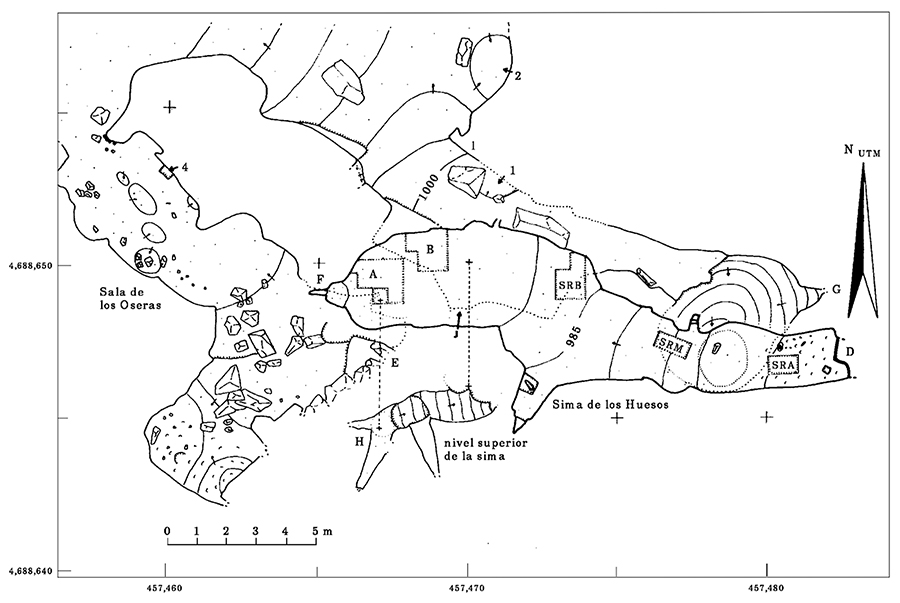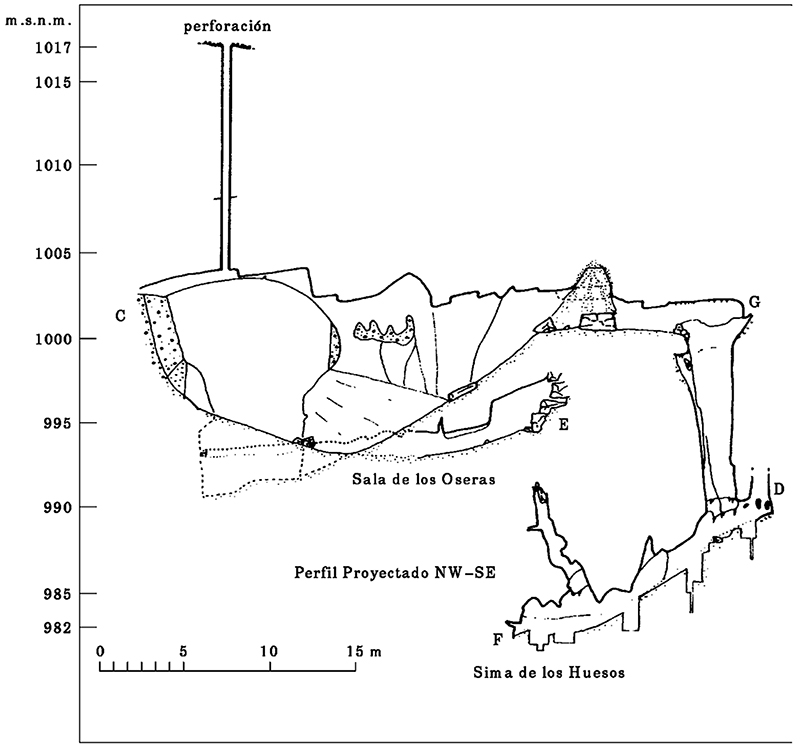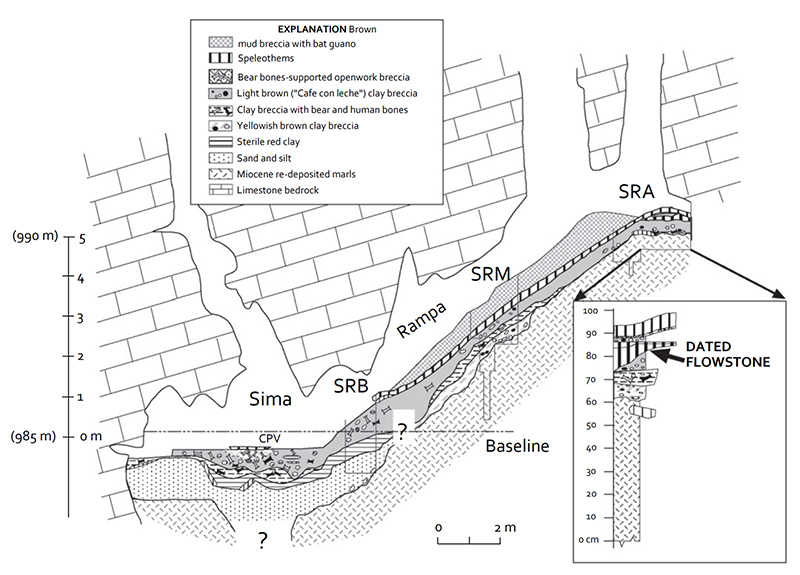Back to Don's Maps
 Back to Archaeological Sites
Back to Archaeological Sites
 Back to the review of hominins
Back to the review of hominins
Atapuerca
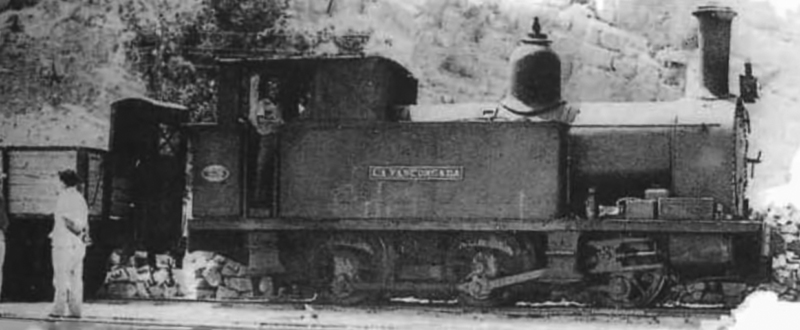
The site of Atapuerca is available to us as a result of the building of a narrow gauge railway, opened in 1901, to service a mining company transporting ore to Burgos.
The line was loss-making, and was closed by 1910. The railway cutting fell into disrepair, the lines were torn up for scrap in 1947, and the area was abandoned.
Above: The original train.
Photo: Eloy García Fuentes.
Source: https://www.academia.edu/25037054/Atapuerca
An interesting side issue is that the railway should never have been built through the area in the first place. The Sierra Company Limited, the British company the British company that was building the railway, hired the engineer Pablo Pradera Asterloa, who had interests in quarries in the area, as a proxy. In Ibeas de Juarros, this character is still known as 'the one who deceived the Englishman'. This would explain the otherwise incomprehensible deviation of the route to cross the Sierra, which was done in order to open up new fronts for limestone exploitation.
Text above: adapted from https://www.academia.edu/25037054/Atapuerca
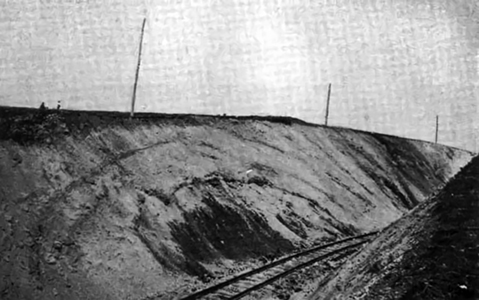
In 1924, a photograph taken by the palaeontologist Royo y Gómez shows the abandoned tracks still in the Trinchera.
Proximate source: https://www.academia.edu/25037054/Atapuerca
Source: Guide to an excursion to Burgos prepared by Royo y Gómez.
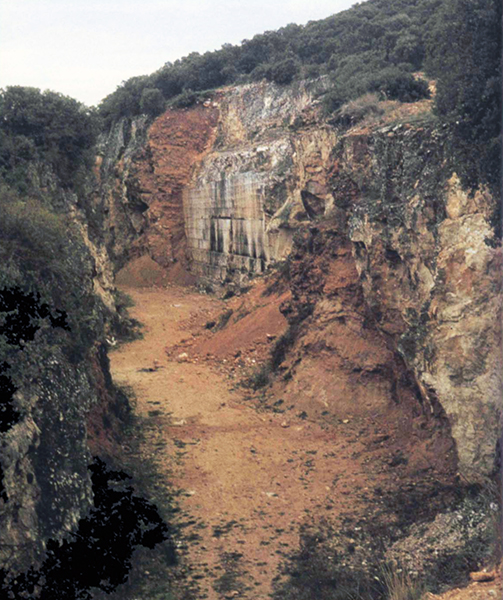
In this photo taken after the rails were ripped up for scrap, we can see that at least some of the limestone made available by the otherwise unnecessary and expensive diversion into the Sierra Atapuerca had been harvested by this time, probably for building, given that it has been taken out in large rectangular blocks, from the wall on the right.
From the staining of the wall, perhaps by lichens and algae, the removal of limestone blocks appears to have taken place a considerable time before this photograph was taken, perhaps at a time when the rails were still in existence to facilitate transport to Burgos.
Photo: EWC Archive
Source: https://www.academia.edu/25037054/Atapuerca
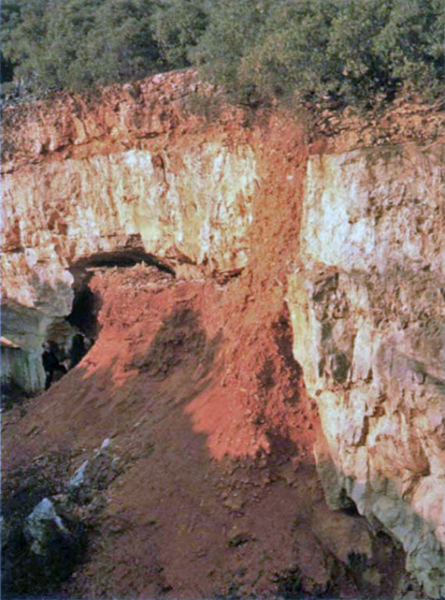
The 500 metre long section up to twenty metres deep running in an arc roughly north to south through the southern part of the Sierra del Atapuerca passed through numerous caves and filled in cavities containing Pleistocene sediments containing bones and lithic industries, displaying their strata and offering immediate access to the sediments and the treasures they contained.
Listed in chronological order of human occupation, the cave sites are Sima del Elefante, Gran Dolina, Galería, Sima de los Huesos, Portalón and Mirador. The outdoor sites include Hotel California, Hundidero, Fuente Mudarra and Valle de las Orquídeas.
(left) Trinchera Galería in 1963, eroded by rain before excavations began.
The hole in the background is Trinchera Zarpazos, not discovered until 1978.
Photo: EWC Archive
Source: https://www.academia.edu/25037054/Atapuerca
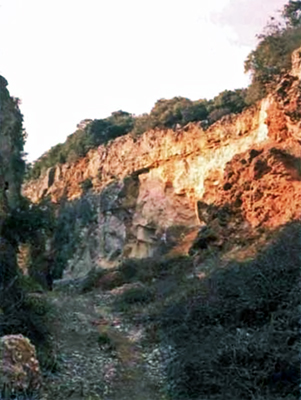
The construction of the Trinchera del Ferrocarril exposed the sediment-filled caves containing fossils and stone tools. In the foreground, the Calería site, and in the background, the so-called Oran Dolina in 1963.
Photo: L Uribarri / CEí)
Proximate source: https://www.academia.edu/25037054/Atapuerca
http://www.iphes.cat/atapuerca has a good overview of the various sites in the archaeological area now referred to as Atapuerca.
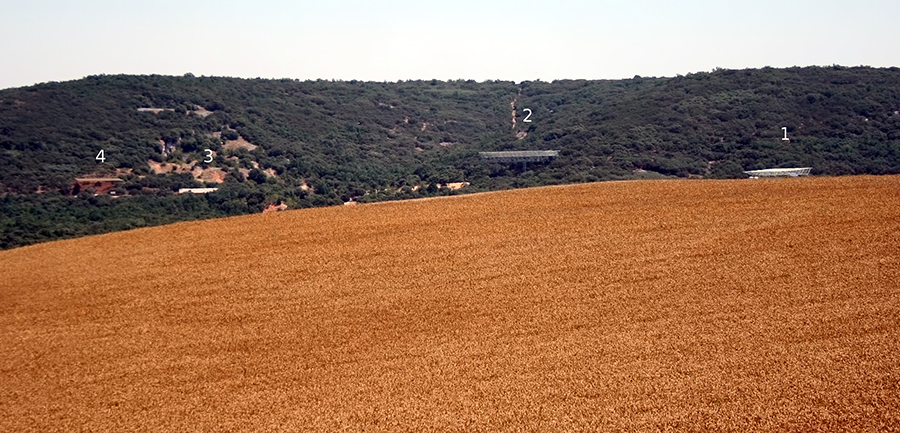
Location of the excavation sites of the Atapuerca region in the railway cutting (shown by the visible protective roofs)
(1) Entrance to the cutting; (2) Sima del Elefante; (3) Galería; (4) Gran Dolina
Photo: Mario Modesto Mata
Permission: GNU Free Documentation License, Version 1.2 or any later version
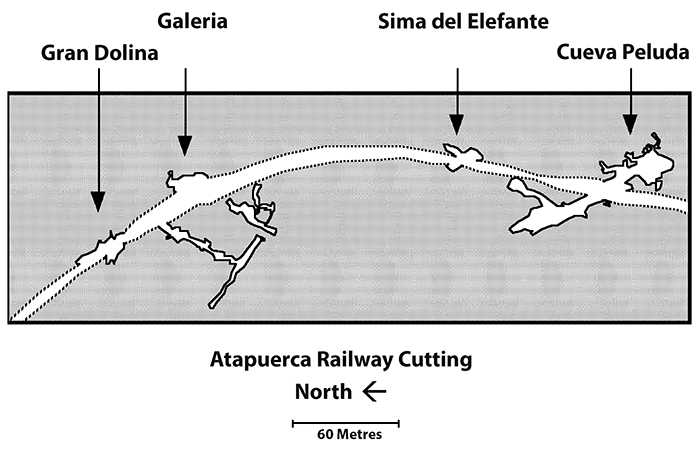
Plan of La Trinchera del Ferrocarril, in the archaeological site of Atapuerca (Spain)
Photo: After José-Manuel Benito / Locutus Borg
Permission: This work has been released into the public domain.
The Gran Dolina Site of Atapuerca
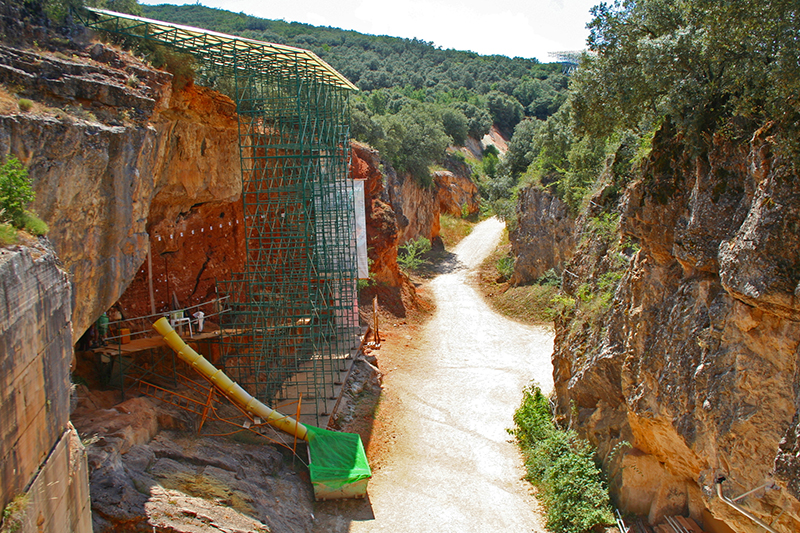
Trinchera Galería, The Gallery Trench, Atapuerca, Spain, where Homo antecessor was found during excavations for the Gran Dolina railway cut in northern Spain's Sierra Atapuerca.
On the left we can see the reminders of harvesting of limestone blocks from the cliff, which destroyed part of the archaeological remains.
Photo: Mario modesto
Permission: Creative Commons Attribution-Share Alike 3.0 Unported license.
Text: Wikipedia
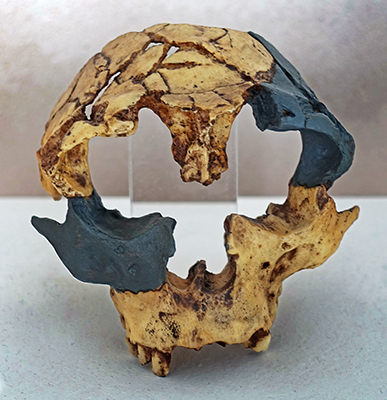
Homo antecessor
Cranial fragments from Gran dolina, Atapuerca, Spain, layer TD-6, also described as ATD6.
Circa 780 000 BP
Fossils from the Gran Dolina railway cut in northern Spain's Sierra Atapuerca are from a hitherto unknown species of early human, according to the site's excavator José Bermúdez de Castro of the National Museum of Natural Sciences, Madrid, and his colleagues. They named the newly identified species Homo antecessor (from the Latin for pioneer or explorer), and claim that it is directly ancestral to both modern humans and Neanderthals. The Gran Dolina fossils - nearly 80 postcranial, cranial, facial, and mandibular bones as well as teeth of at least six individuals - were excavated between 1994 and 1996.
A key specimen is a partial facial skeleton of a juvenile, estimated to be ten to eleven years old, recovered in 1995. The fossils exhibit both seemingly modern features, such as sunken cheekbones with a horizontal rather than vertical ridge where upper teeth attach and a projecting nose and midface, and more primitive ones, including prominent brow ridges and premolars with multiple roots. The level in which the fossils were found, TD6, is dated by a reversal in the earth's magnetic field to more than 780 000 years ago. So far this level has been exposed only in a test pit of six square metres, but the excavators are confident that many more human fossils will be found when larger excavations reach the level some years in the future.
( The Australian museum at https://australianmuseum.net.au notes that although many experts consider these remains to be part of an early and variable Homo heidelbergensis population, the discoverers believe the fossils are different enough to be given a new species name Homo antecessor - Don )
Photo: Don Hitchcock 2018
Source: Anthropos Pavilion/Moravian Museum, Brno, Czech Republic
Text: Adapted from https://archive.archaeology.org/online/news/gran.dolina.html
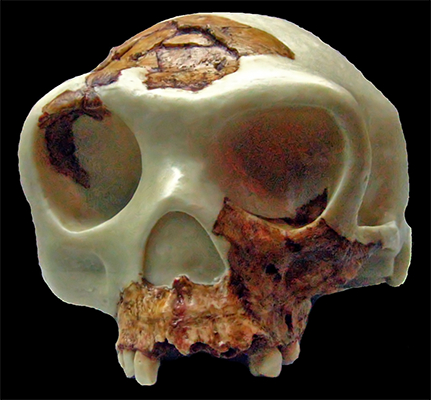
Reconstruction of Homo antecessor skull at Museu d'Arqueologia de Catalunya (Barcelona, Spain) Reconstrucción del cráneo de Homo antecessor, Museo de Arqueología de Cataluña (Barcelona, España).
Photo: Xvazquez
Source: Museu d'Arqueologia de Catalunya (Barcelona, Spain)
Text: Adapted from https://archive.archaeology.org/online/news/gran.dolina.html
Permission: Public Domain
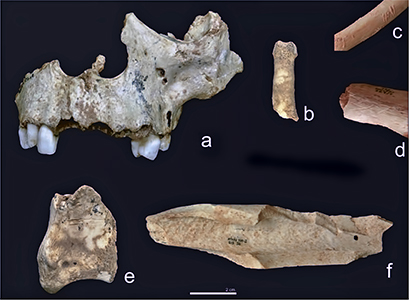
a) Homo antecessor jaw with percussion stigma.
b) Homo antecessor proximal phalanx with cut marks.
c) Homo antecessor rib processed during corpse defleshing.
d) Striations on Homo antecessor tibia fragment produced while Achilles heel was being cut.
e) Equine phalanx with cut marks produced during skinning.
f) Deer radius with removals during fracturing to access bone marrow.
Photo: P. Saladié / IPHES)
Source and text: Carbonell et al. (2014)
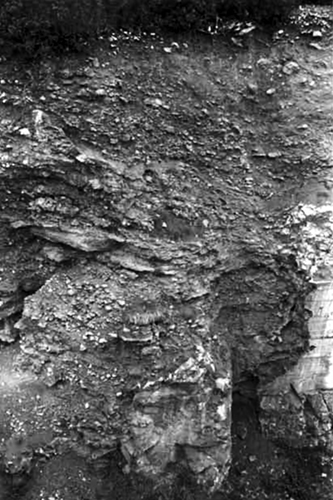
Gran Dolina in May 1976.
A few years earlier, the site had been partly destroyed by the extraction of limestone rock.
Photo: Latova/IPHE).
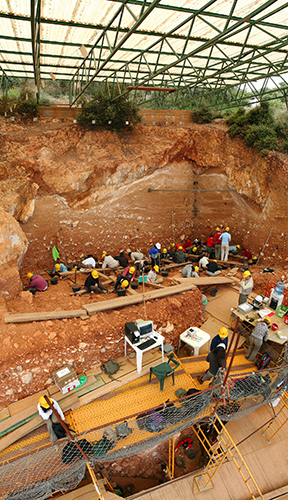
Excavations at the site of Gran Dolina, in Atapuerca (Spain), during 2008.
Panoramic photography formed using 3 individual photographs with Hugin software.
TD-10 archaeological level is being excavated where the most of the people are. It is a Homo heidelbergensis camp.
Under the plank, we can observe a woman with red sweatshirt excavating the TD-6 archaeological level, where the first remains of Homo antecessor were found.
Photo: Mario Modesto Mata
Text: Wikipedia
Permission: Creative Commons Attribution-Share Alike 3.0 Unported license
3D model of the Gran Dolina site in 2012.
Brown areas indicate stratigraphic units.
Grey areas are the wall and roof of the cave.
The excavation surfaces in 2012 have been marked with the letter S.
S1 – TD10 excavation surface.
S2 – TD5 excavation surface.
S3 – TD4 excavation surface.
The site of 'Torreón' and the test pit excavation are situated in TD6.
(D) Stratigraphic units (TD1 to TD11) and sedimentary facies of the Gran Dolina site 19.
Photo and text: Campaña et al. (2016)
Excavation in progress at the Gran Dolina site in 2012.
Photo: Mario Modesto Mata
Source: https://www.spain.info/en/places-of-interest/site-atapuerca/
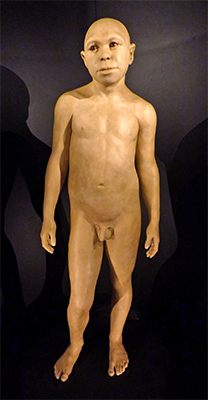
Homo antecessor reconstruction, Museo de la Evolución Humana (Burgos, Spain).
Reconstruction by Élisabeth Daynès (2014), based on fragments from Gran Dolina, Atapuerca, Spain (ATD6-15, ATD6-96, ATD6-96), ca. 850 ka.
The reconstruction is that of an adolescent male of circa 10 years (the 'Boy of Gran Dolina').
Photo: Élisabeth Daynès
Source: Museu d'Arqueologia de Catalunya (Barcelona, Spain)
Text: Adapted from https://archive.archaeology.org/online/news/gran.dolina.html
Permission: GNU Free Documentation License, Version 1.2
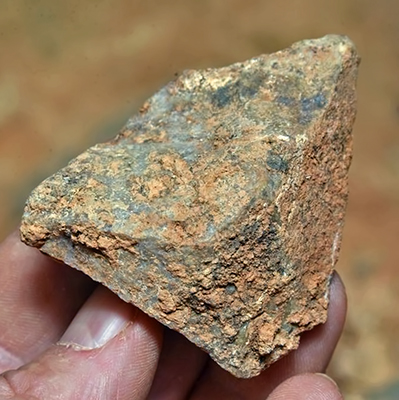
Gran Dolina stone tool.
This is one of tools recently found at the Gran Dolina dig, in strata corresponding to between 500 000 and 600 000 years ago. Used for cutting meat, these tools build a bridge linking the Homo antecessor period with that of the new hominids – the pre-Neanderthals whose remains were found in another part of the site known as the Sima de los Huesos (Pit of the Bones).
Experts had long been stumped by the sudden lack of evidence of hominids in Atapuerca spanning hundreds of thousands of years. The first human fossils found here date back 1.2 million years and belong to an unidentified primitive hominid, although there are stone tools that date back as far as 1.4 million years.
Then, 850 000 years ago, a completely new species appeared: Homo antecessor, whose fossils and tools have been unearthed along with the remains of his carnivorous meals, both animal and human. Subsequently, there is a mysterious interim with no evidence of a human presence until the pre-Neanderthals arrived about 400 000 years ago. “What happened?” says Martinón-Torres. “Did they abandon the cave; did its roof collapse? Had the humans left or did we not know how to find them?”
Like H. antecessor’s artifacts, the two new tools were found at the Gran Dolina dig, in strata corresponding to between 500 000 and 600 000 years ago. Used for cutting meat, these tools build a bridge linking the Homo antecessor period with that of the new hominids – the pre-Neanderthals whose remains were found in another part of the site known as the Sima de los Huesos (Pit of Bones).
Later, around 110 000 years ago, the Neanderthals were already fully formed as a species at Atapuerca, as evidenced by the remains of a toe and tools found in the Statues Gallery. There they remained until about 40 000 years ago, when their entire species was wiped out. Finally, Homo sapiens showed up, occupying the area from the Neolithic period, around 7 000 years ago, until the present day.
“I don’t think there is any other site in the world where all the human species to inhabit Europe have been found: pre-Homo antecessor, Homo antecessor, pre-Neanderthals, Neanderthals and Homo sapiens,” says Maria Martinón-Torres, director of the National Research Centre on Human Evolution, CENIEH, The Centro Nacional de Investigación sobre la Evolución Humana.
Photo: AOC/EIA
Text: Heather Galloway
Source: https://english.elpais.com/arts/2020-07-29/new-discovery-fills-gap-in-atapuercas-history-of-human-evolution.html
Horizontal excavation of Gran Dolina, level TD10, 2007 dig.
Photo: J. Mestre/IPHES
Source and text: Carbonell et al. (2014)
The Gran Dolina or Dolina railway cutting site is a huge cavern, which has been excavated since September 1981. Its sediments were divided into eleven stratae, TD-1 to TD-11.Text above: Wikipedia
TD-11: Mousterian tools found.
TD-10: presumed to have been a Homo heidelbergensis camp with tools and bison fossils.
TD-8: accessible since 1994, it contained remarkable carnivore fossils.
TD-7: a bovine leg in anatomical position was recovered in 1994.
TD-6: (Aurora stratum): In 1994 and 1995, over 80 bone fragments of five or six hominids found, between 850 000 and 780 000 years old, being at least 250 000 years older than any other hominid yet discovered in western Europe.
About 25% of the bones have manipulation marks that suggest cannibalism. Classification of these remains is still being debated; suggestions range from Homo erectus to Homo heidelbergensis and Homo antecessor. Some researchers, who are familiar with the stratigraphic material of Gran Dolina, argue that Homo antecessor may be the ancestor of Homo heidelbergensis, who in turn gave rise to Homo neandertalensis. The Homo erectus-like fossils were also found with retouched flake and core stone tools.
TD-5: is assumed to have been a carnivore den.
TD-4: (dated to 780 000 BP), four lithic pieces were found during the 1991 excavation and several remnants of Ursus dolinensis, a sparsely described bear species. The species has been described as the most primitive of all cave bears, and smaller than a black bear. It has a slender body comparable to brown bears (Ursus arctos) and noticeably gracile features of the cranial and mandibular bones, that to some extent resemble those of Ursus arctos and Ursus etruscus. Yet its overall morphological characteristics suggest a kinship with the line of the speloid (cave dwelling) bears. Finally Garcia and Arsuaga have concluded that Ursus dolinensis is the ancestor of Ursus savini and to be very close to the common ancestor of Ursus arctos.
TD-3: no data available.
At the lowest levels, TD-1 and TD-2, no fossils were found.
The Railway Cutting Complex of Caves in the Sierra de Atapuerca
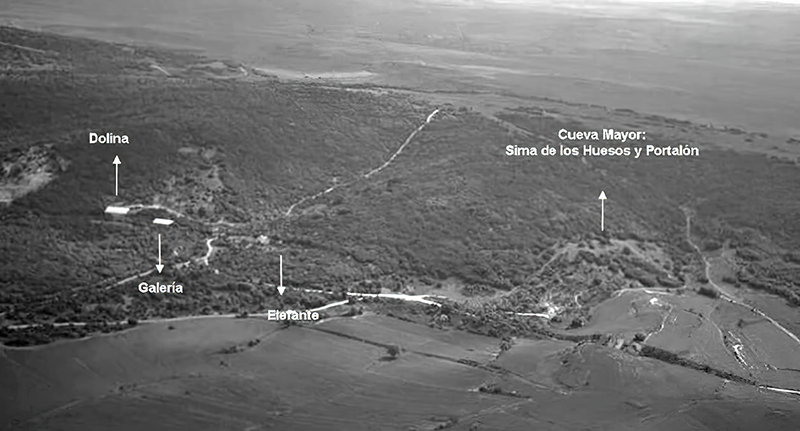
Aerial photograph of the general area, labelled.
Photo: Ortega et al. (2008)
The cave system of the Trinchera del Ferrocarril ( Railway Cutting) and Cueva Mayor (The Big Cave) in the Sierra de Atapuerca.
I have (I hope correctly!) translated the original Spanish names for an English speaking audience.
Click here for the original map
Trinchera Ferrocarril - Railway Cutting
Cueva Mayor - The Big Cave
TP = Trinchera Penal (Criminal trench )
TD = Trinchera Dolina (Doline trench)
(A doline is a closed depression, a pit, formed by solution of the surface rock or a subsidence collapse into an underground void).
TZ, TG, TN = Tres Simas (Three pits) Complex (Trinchera Zarpazos (Claws trench), Trinchera Galería (Gallery trench), Trinchera Norte (North trench).
TE = Trinchera Sima del Elefante, Elephant pit trench. This contains the earliest evidence of humans in western Europe - fragments of a jawbone and teeth date to 1.1–1.2 million years ago.
SH = Sima de los Huesos, Pit of bones.
Cueva peluda - Hairy Cave
Cueva del compresor - Compressor Cave
Galeria baja - Lower gallery
Galeria del betún - Bitumen gallery
Galeria del Silo - Silo gallery
Cueva del Silo - Silo Cave
Entrada a Cueva Mayor - Entrance to the Large Cave
Galeria del silex - Flint gallery
( note that it may be significant that silo can mean a pit or hole to preserve grain - Don )
Photo and text: After Cuenca-Bescós, Rofes (2004)
A very useful later (2016) map of the area.
The map allows us to see clearly the difference between the caves and the trenches. In particular, Gran Dolina, the Galería, Sima del Elefante are shown to be trenches, archaeological digs, not connected directly to the caves.
In addition, the name 'Bitumen Gallery' seems to have been dropped, and replaced by the 'Statues Gallery'. El Portalón (the gateway) referred to in later papers but not on the original maps is shown. The name 'Sala de los Cíclopes' (salle or room of the Cyclops) has been added.
Photo: UtaUtaNapishtim
Permission: This image has been released into the public domain.
Source: Wikimedia commons
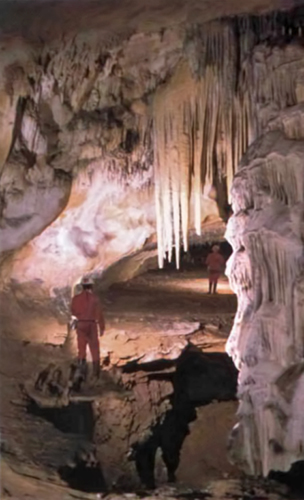
Galería del Sílex, a Bronze Age sanctuary discovered in 1972 by the Grupo Espeleológico Edelweiss de Burgos, is located in a previously blocked side branch of the Cueva Mayor.
The Calería del Sílex had remained intact for thousands of years, unlike the rest of the galleries. That is why it preserves very fragile structures, such as these stalactites.
Photo: F. Lázaro/CEE
Source: https://www.academia.edu/25037054/Atapuerca
The Galeria Site of Atapuerca
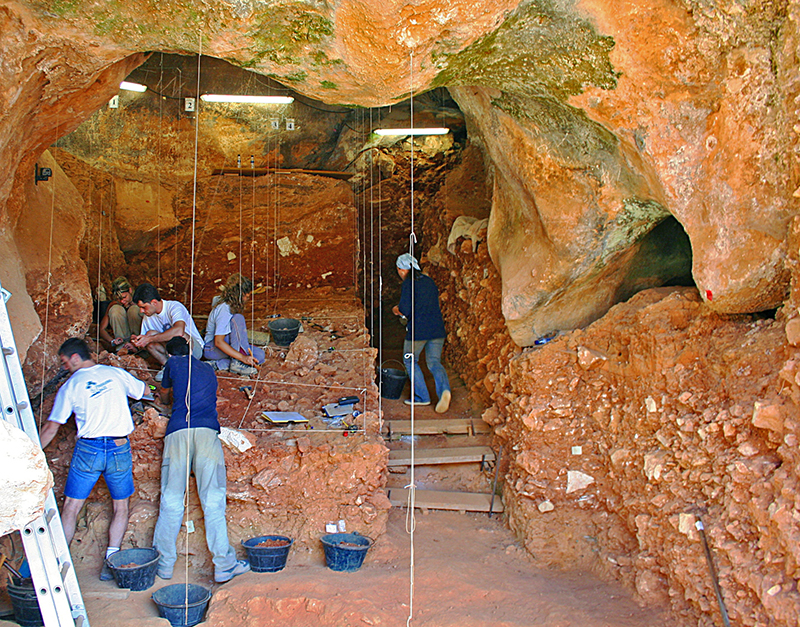
TZ, Trinchera Zarpazos, Claws Trench, Claws Cave, Covacha de los Zarpazos, part of the Galería system, in the 2006 campaign.
Photo: Mario modesto
Permission: GNU Free Documentation License, Version 1.2 or any later version
Text: Wikipedia
( it seems to me that the Claws Trench is so named because of the claw-like nature of the roof of the trench, as above - Don )
Galería (1978 to present): Among numerous faunal and floral fossils, a jaw fragment was found during the 1970s and a skull fragment in 1995, which both belong to Homo heidelbergensis. They date to between 600 000 and 400 000 BP.
Text above: Wikipedia
General view of the Galería excavation.
( note the distinctive shape of the roof of the Covacha de los Zarpazos (TZ), apparently so named (claw cave) because of the resemblance to an animal's claw - Don )
Photo: J.Mestre/IPHES.
Source and text: Carbonell et al. (2014)
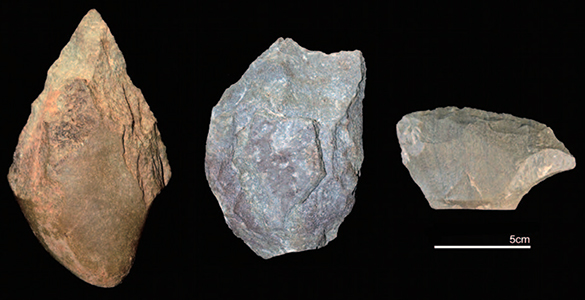
Left to right:
Quartzite handaxe from TG07
Quartzite cleaver from TN2B
Quartzite sidescraper from GSU11
Photo: P. García-Medrano/A. Ollé/IPHES
Source and text: Carbonell et al. (2014)
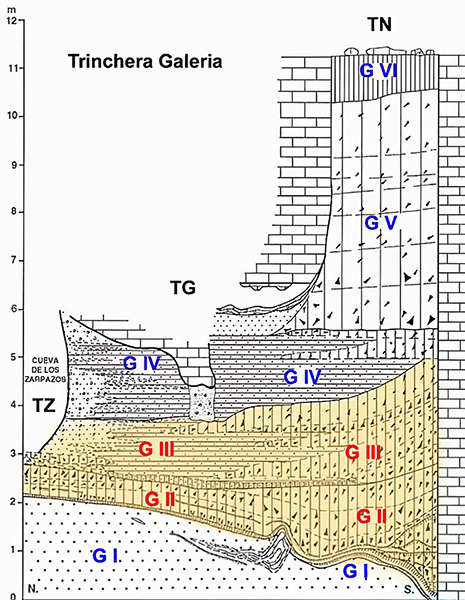
The Trinchera-Galería deposit, consists of three parts:
• Covacha de los Zarpazos (TZ),
• Galería (TG)
• A vertical conduit, Boca Norte (TN).
Units GII and GIII are those that have provided the rich fossil evidence of the site.
Photo and text: http://personal.iesvegadelturia.es/jvaltuena/Evolucion/m5/m5_u5_texto/m5_u5_033.html
Summary of dating of the Trinchera-Galería deposit
Source: Galindo-Pellicena et al. (2011)
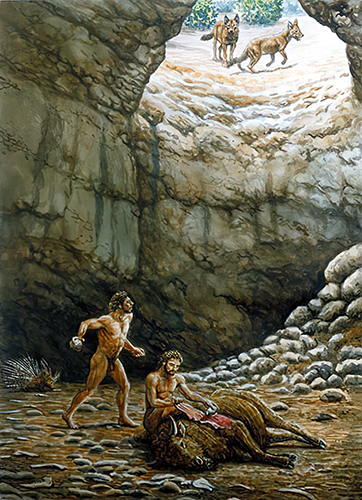
Around 450 000 years ago, the Trench-Gallery, TG, functioned as a natural trap where humans came sporadically to take advantage of the meat of animals that accidentally fell through the vertical mouth that connected with the outside. Some carnivores also fell into the trap.
Painting: Mauricio Antón / MSF.
Source and text: http://personal.iesvegadelturia.es/jvaltuena/Evolucion/m5/m5_u5_texto/m5_u5_033.html
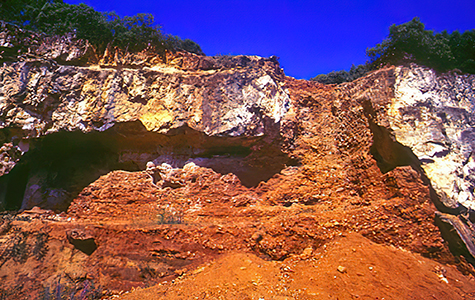
The original sink hole and trap eventually filled up with sediments.
The Galería site consists of 6 stratigraphic units, the basal unit (GI), is composed of cave interior sediment where no fossil remains or lithic industry were found, and where the Matuyama / Bruhnes paleomagnetic inversion has been detected., which indicates an age of at least 780 000 years.
Above this first base section, is the GII level, in whose upper part there are layers of bat guano, which indicate the moment when the cave opened to the outside. From this level, the cave is filled with sediments introduced from the outside, giving rise to the formation of the deposit.
The sediments of levels GII and GIII contain Galeria's fossil evidence: lithic tools, human fossils and fauna.
The fossiliferous sediments that filled the Gallery cavity belongs to the Middle Pleistocene and are older than 200 000 BP, although it is not easy to know how much older it is. Given the evolutionary state of all the different species of animals, it seems to point towards an age between 200 000 and 400 000 BP, but not older.
Photo and text: http://personal.iesvegadelturia.es/jvaltuena/Evolucion/m5/m5_u5_texto/m5_u5_033.html
The plan view of the Galería karstic complex shows the three conduits (Zarpazos: TZ, Galería: TG, and Tres Simas norte: TN) that have contributed to the infilling of the cavity.
Source: Demuro (2014)
Sima del Elefante
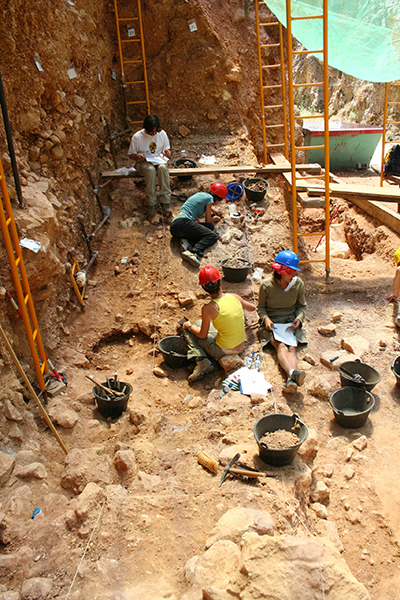
Excavation in la Sima del Elefante during the 2006 Campaign.
Photo: Mario Modesto Mata
Permission: Creative Commons Attribution-Share Alike 3.0 Unported license
Profile of the Sima del Elefante site in 2006.
Photo: Mario Modesto Mata
Permission: Released into the public domain
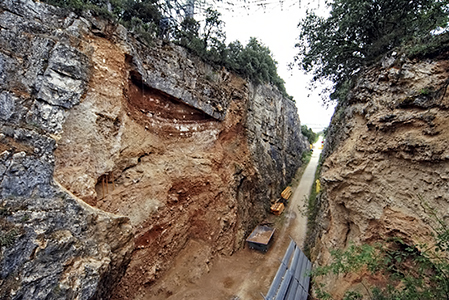
View of Sima del Elefante cave.
The Sima del Elefante is a cavity 25 m high (7 m below the level of the Trinchera del Ferrocarril) and 15 m wide. It is filled with a deposit of sediments organised in at least 15 levels (from 7 to 21) that date back more than a million years. It is the largest deposit in the whole 'Railway Cutting' series of deposits.
The name of the Sima del Elefante, dates back to the time when Professor Trino Torres was investigating the site, since it was said at the time that a pachyderm molar had been found. Later, the existence of this genus was confirmed here, when a postcranial bone was found, with which it was possible to reaffirm the reason for its name.
Level TE 9 has yielded a small assemblage of Cretaceous flint tools and bones with cut marks and consumption fractures, but the main discoveries were made in 2007 and 2008 with the exhumation of a mandible and a phalanx of the oldest human being in Europe. These hominids never entered the cave, but would have carried out their activities in the vicinity of the entrance and small streams of water would have introduced the archaeological remains into the interior. At this time the inhabitants of the cave were crows, mice and shrews.
The original narrow, vertical walled trench/excavation shown here was dug in 1992. Recent excavations show the reddish/brown colouration of freshly dug clay/limestone deposits typical of this area.
Photo: Huguet et al. (2017)
Text: http://diariodeatapuerca.net/Simadelelefante.pdf
Additional text: https://grupoedelweiss.com/pdf/Cubia20.Trino_Atapuerca.pdf
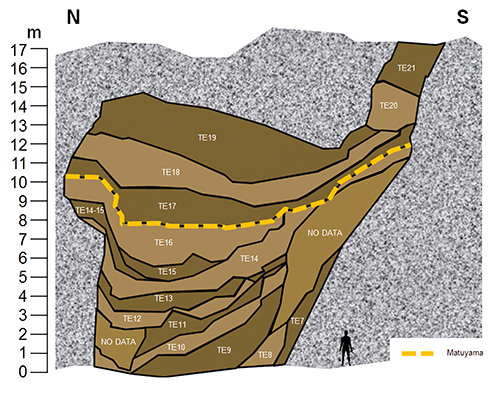
Stratigraphic sequence of the Sima del Elefante or Trench of the Elephant (TE).
( note that we can directly superimpose this diagram on the photo above. The entry to the sinkhole of the Sima del Elefante is the reddish coloured shallowly excavated 1.5 - 2 metre wide channel on the right which reaches the surface in the photo above - Don )
The TE15 ─ TE17 layers are the only ones that do not contain bone. Stone tools have mostly appeared in TE9 and TE8 layers, as well as a jaw, tooth, and phalanx.
The level labelled as Matuyama on the diagram refers to the Brunhes–Matuyama reversal, named after Bernard Brunhes and Motonori Matuyama, which was a geological event, approximately 781 000 years ago, when the Earth's magnetic field last underwent reversal. This is an important marker, since all the deposits below that level are older than 781 000 BP.
( note that this also means that, if we assume a constant rate of deposition, the lowest levels are of the order of 1.5 million years old, or older. This date has been confirmed by later discoveries, with a flint knife found with an estimated age of 1.4-1.5 BP, see below - Don )
Photo: UtaUtaNapishtim
Permission: This image has been released into the public domain.
Text and source: Wikimedia commons
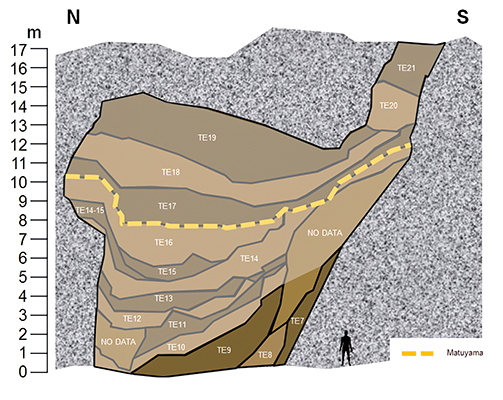
Stratigraphic sequence of the Sima del Elefante or Trench of the Elephant (TE).
( This version of the diagram above shows the early stages of the infill of the cave/sink hole, with just the layers TE7, TE8, and TE9 laid down in succession, as detritus falls through the hole in the surface above, and each of the layers is deposited at its angle of repose.
We should note once more that the stone tools have mostly appeared in TE8 and TE9 layers, as well as a jaw, tooth, and phalanx. They have appeared not as the result of occupation of the cave, but by falling into the cavity from the surface above.
A similar sinkhole, also with a narrow entry, at Naracoorte in South Australia is a treasure house of animal fossils - Don )
Photo: UtaUtaNapishtim
Permission: This image has been released into the public domain.
Text and source: Wikimedia commons
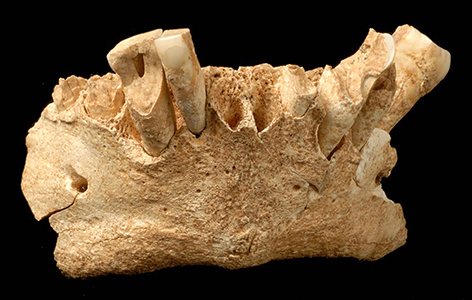
Sima del Elefante jaw
The jaw of the oldest hominin in Europe, discovered in 2007 in the Sima del Elefante at the Atapuerca site.
The jaw dates to 1.1–1.2 million years ago.
Photo: CENIEH. The Centro Nacional de Investigación sobre la Evolución Humana is a scientific and technological facility open to the use of the national and international scientific and technological community. It is located in the Spanish city of Burgos.
Proximal source: https://www.nationalgeographic.com.es/ciencia/actualidad/los-primeros-humanos-europeos-usaron-fuego-para-consumir-alimentos_10959
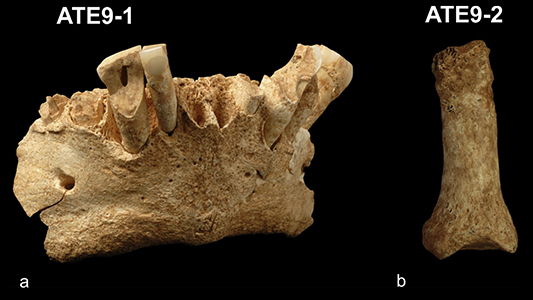
Human remains from TE9c.
a. A jaw of an adult hominin (ATE9-1).
b. A fifth proximal hand phalanx (ATE9-2).
Dental calculus from a hominin molar from the Sima del Elefante site (Atapuerca, Burgos) shows evidence for plant use at 1.2 ma, including starchy carbohydrates from a species of grass from the Triticeae or Bromideae tribe that was eaten raw. There is no evidence for processing of the starch granules which are intact and undamaged. Additional evidence includes fragments of non-edible wood found adjacent to an interproximal groove suggesting oral hygiene activities.
Photo and text: Huguet et al. (2017)
Additional text: https://human-evolution.blog/category/atapuerca/sima-del-elefante/
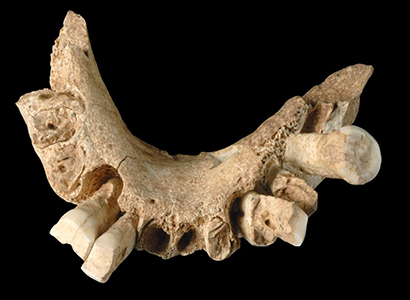
Sima del Elefante jaw
Photo: https://www.nbcnews.com/id/wbna23813443
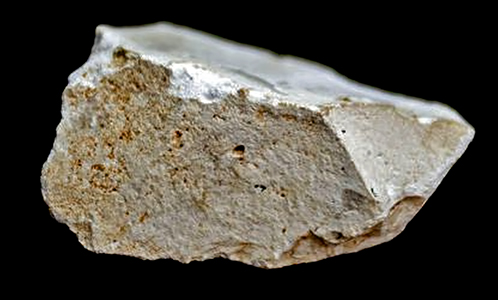
Sima del Elefante knife
Archeologists excavating at Atapuerca have unearthed a small flint knife they say was made 1.4 million years ago, making it the oldest evidence of the presence of hominids at the site near Burgos, in northern Spain.
The tiny, three centimetre stone fragment with a sharply defined edge seems to support theories that hominids have maintained a permanent presence in Europe for nearly 1.5 million years, José María Bermúdez de Castro, one of the three excavation directors, says.
"This would demolish the widely accepted theory that Europe was populated in waves and was empty of hominids for long periods of time," he adds.
The small knife was discovered at the Sima del Elefante cave infill, two metres below the spot where archaeologists discovered a jawbone fragment in 2007 that, until this latest find, had been considered the oldest evidence of the presence of hominids in Europe.
"The site covers a very long period of time, practically from when the first humans arrived in Europe up to the present day," says Bermúdez de Castro. "If we add up all the sites found in the Sierra de Atapuerca, it covers a period from one and a half million years ago."
The site has been under excavation since 1978. In 2000 it was classed by UNESCO as a world heritage site. Since then, they have found skulls, bones and teeth belonging to what archaeologists call Homo antecessor, who lived between 850 000 and 950 000 years ago. "Most periods are represented here. That's what makes it a spectacular and unique site," Bermúdez de Castro says.
A hand axe found at Atapuerca's Gran Dolina led experts to link that large cave with the Sima de los Huesos (Pit of Bones), which contains remains of the Homo heidelbergensis species, a human predecessor, dating back more than 400 000 years.
Another object found at Atapuerca, a 1-million-year-old sandstone chopping tool, led experts to hypothesise a link between 800 000-year-old Homo heidelbergensis remains with the oldest hominid remains at the site (dating back as far as 1.2 million years). But the dig has still not unearthed evidence of more recent prehistoric humans such as Neanderthal and Cro-Magnon man, says Bermúdez de Castro.
These missing links leave a gap of some hundred thousand years for which the archeologists have found tools but no human remains yet. But the team is confident more will be revealed.
'There are just some short periods for which there are no remains,' says Bermúdez de Castro. 'I think bit by bit we are finding them.' Through their finds, his team has reconstructed details of our ancestors' lives.
In Homo antecessor's time, Atapuerca was inhabited by hunters, around 30 of them spread over some 20 square kilometres. They spent time in caves, but lived mostly in the open air in an area well supplied with water, vegetation and animals, including lions, hippos, rhinos and bison, says Bermúdez de Castro: "Their physiology was probably different from ours. They could better stand the cold and probably had a good layer of fat under their skin, and more hair."
Photo: Santi Otero / EFE
Source and text: Emilio de Benito, 2013, at: https://english.elpais.com/elpais/2013/08/06/inenglish/1375792164_416099.html
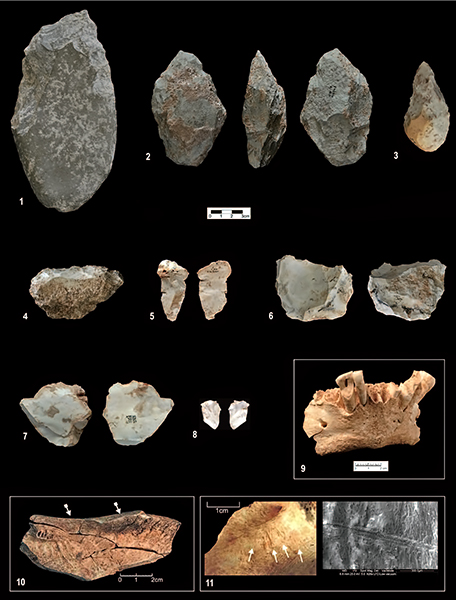
Archaeo-palaentological material from Sima del Elefante.
1: Cleaver-like tool (Unit TE18, sandstone).
2: Sandstone handaxe (Unit TEsup).
3: Quartzite point (TEsup).
4: Retouched flake (sidescraper) of Neogene chert (TE19).
5: Retouched flake (sidescraper) of Cretaceous chert (TE13).
6: Cretaceous chert core (TE9c).
7: Cretaceous chert flake (TE9c).
8: Cretaceous chert flake (knap- ping debris) (TE9c).
9: Homo sp. mandible (TE9c).
10: Macromammal bone with evidence of fresh fracture (arrows (TE9c).
11: Left, cut marked bovid vertebra (TE9c); right, electron microscope detail of cut marked bovid mandible (TE9c).
Photos: A. Ollé/J.Mestre/R.Huguet/IPHES
Source and text: Carbonell et al. (2014)
Relative ages of the main deposits
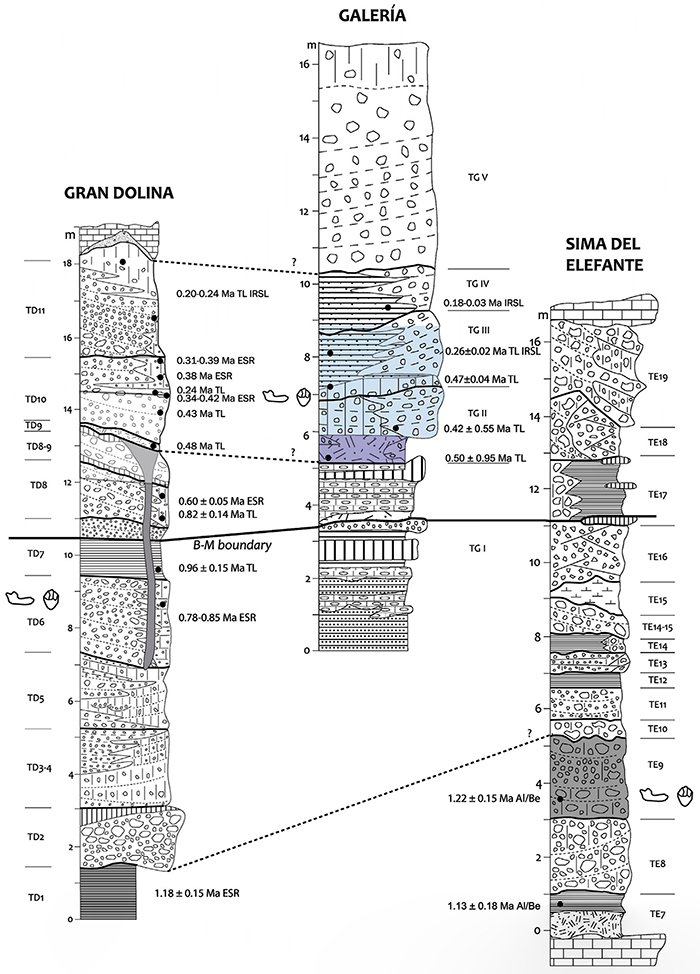
Main geochronological guidemarks of the three infillings of the Trinchera.
A palaeomagnetic reversal attributed to Matuyama-Brunhes boundary is observed in the three sequences.
Cosmogenic burial dates of 1.22 Ma are provided for the human remains in the TE9 layer of Elefante and could be coeval with the basis of Dolina layers dated by ESR-OB to about 1.10 - 1.30 Ma.
Source and text: Falguères at al. (2013)
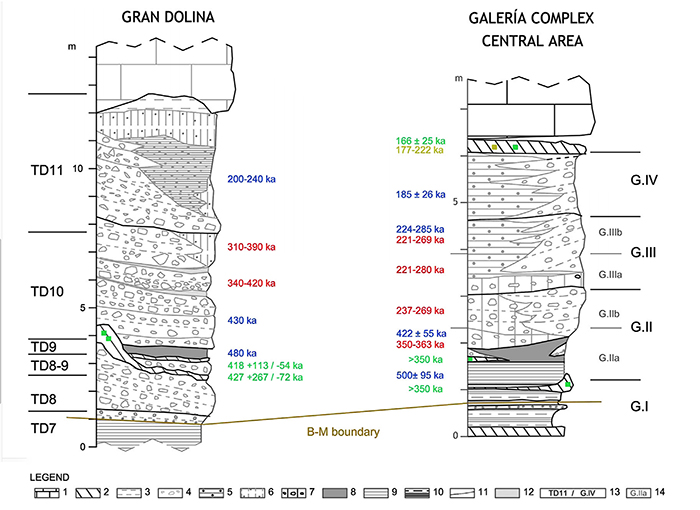
Chronostratigraphic correlation between upper part of Dolina and Galería sequence. U-Th ages are in green and brown; TL-IRSL ages are in blue; ESR-US ages are in red.
1) Upper Cretaceous limestone and dolomite (wall and roof of caves)
2) Speleothems
3) Terra rossa
4) Limestone blocks, cobbles and gravels
5) Alternance of fine and medium pebbles and clay loam
6) Lutites, clay loam
7) Gravels and clay loam
8) Bat guano and clay loam
9) Laminated loamy clay
10) Laminated sandy clay
11) Main stratigraphical unconformities
12) Main continuous archaeological levels
13) Allostratigraphic units
14) Archaeo-palaeontological levels.
Source and text: Falguères at al. (2013)
Cueva Mayor
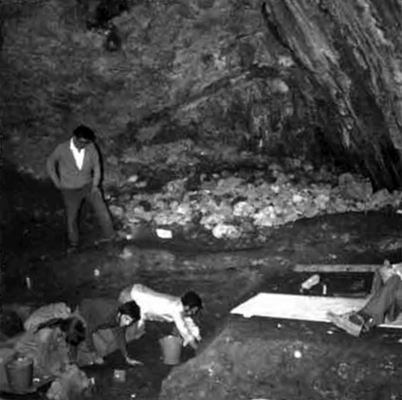
First archaeological excavation in the Cueva Mayor, begun in 1973 by Professor Juan María Apellóniz, standing, in this photograph taken in 1978.
Next to him are (from right to left) Salvador Domingo, Armando Vega and Rosa Ruiz.
Photo: CEE Archive
Proximate source: https://www.academia.edu/25037054/Atapuerca
Estatuas site Mayor cave.
Neanderthal DNA discovered in sediment
Tuesday, 27 April, 2021
An international research team has reportedly recovered the nuclear DNA of several Neanderthal individuals from the sediment of two Siberian caves and the Galería de las Estatuas, in the Cueva Mayor of the Sierra de Atapuerca (Burgos, Spain).
The research team was led by Matthias Meyer, a senior researcher in the evolutionary genetics group at Germany’s Max Planck Institute for Evolutionary Anthropology. He and his team have previously produced spectacular results at the Sima de los Huesos site, also in the Cueva Mayor, with the recovery of ancient human mitochondrial and nuclear DNA from fossils.
Recently the team decided to explore the possibility of obtaining DNA directly from sediments, avoiding the need to take samples from human bones, which are absent from most sites. It had previously been shown in that it was possible to recover mitochondrial DNA from sediments, but this had not been achieved for nuclear DNA.
Temperature is a primordial factor in the conservation of the DNA molecule: the higher the temperature, the more the molecule degrades. Therefore, the further north the site, the better the conservation will be. Siberia is the ideal place for recovering ancient DNA, but the special characteristics of the Galería de las Estatuas offered a unique opportunity to obtain DNA from sediment in a region situated in more temperate latitudes.
Excavations at the Galería de las Estatuas recovered the remains of animals consumed by Neanderthals and stone tools, in addition to a foot phalanx which is indisputably Neanderthal. Due to their complete isolation, the sediments of this site have remained under constant conditions of humidity and temperature, and have not undergone any alteration by natural agents or interventions by modern humans.
Both nuclear DNA and mitochondrial DNA from several individuals were recovered from the Galería de las Estatuas sediments. The oldest such DNA belongs to a Neanderthal man of an ancient line that has been dated to around 110 000 years old, with a lineage that arose around 130 000 years ago. The date which has been calculated for this ‘radiation’ — namely, the array of lines which emanate from a common ancestor — coincides with the start of the last warm period between two glaciations. The radiation and the improved climate could be linked, because major environmental changes yield major ecological changes, which affect the evolution of many species.
Some thousands of years later, the Neanderthal population of Galería de las Estatuas was genetically different, and associated with a second radiation. Along the stratigraphic sequence, DNA has been identified from at least four women belonging to these newer Neanderthals, who had superseded the old ones. The most modern have been dated to about 80 000 years old, by which time the climate had changed as the last glacial cycle had already commenced.
Published in the journal Science, the team's discovery is set to open a whole new avenue to future research. As noted by the study authors, 'Human fossils will no longer be necessary to identify the inhabitants of a prehistoric cave.'
Photo: ® Javier Trueba - Madrid Scientific Films
Source: https://www.cenieh.es/en/press/news/neanderthal-dna-recovered-sediment-atapuerca-site
Estatuas site Mayor cave.
Sediments from Pleistocene caves contain hominin mitochondrial and nuclear DNA that can be enriched, sequenced, and analysed to reveal the genetic histories of past occupants even in the absence of their skeletal remains.
Shown is a view of pit I at the Galería de las Estatuas, Spain, and stratigraphic column with ages in thousands of years (ka).
Photo: PANTOJA-PÉREZ,NTTF
Source: https://science.sciencemag.org/content/372/6542/eabf1667
Plan of the Sala de los Cíclopes chamber in Cueva Mayor, its side passage Sala de las Oseras and
Sima de los Huesos (by G. E. Edelweiss).
Sala de los Cíclopes was connected with Cueva del Silo cave subsystem through the narrow passage of Tubo de los Vientos. Numbers 2, 3 and 4 correspond to test excavations, that have yielded U. deningeri fossils.
Number 1 indicates the hole where debris from Sima de los Huesos was accumulated in Torres’ excavation in 1976. This overburden was excavated in 1990 and 1991, yielding bear and human fossils. For clarity, the plan of Sima de los Huesos has been superimposed onto the Sala de los Cíclopes and Sala de las Oseras plans, although Sima de los Huesos is actually below.
‘Perforación’’ indicates the shaft drilled from the surface to the ceiling of the Sala de los Cíclopes chamber.
Source: Arsuaga et al. (2001)
Plan of Sala de las Oseras and Sima de los Huesos. For clarity, Sima de los Huesos has been superimposed onto the Sala de los Cíclopes and Sala de las Oseras drawings, although it is actually below. The circle and ellipses in the floor of Sala de las Oseras represent bear wallows. The plan of the passage leading upwards from the roof of Sima de los Huesos has been shifted.
Drawing: G. E. Edelweiss, 1992
Source: Arsuaga et al. (2001)
Profile of Sala de los Cíclopes, and projected profiles of Sala de las Oseras and Sima de los Huesos. Note that the Sala de las Oseras and Sima de los Huesos profiles have been projected on the Sala de los Cíclopes C–D profile (Figure 3), so that actually Sima de los Huesos is not directly below Sala de las Oseras, and the latter is not directly below the passage from the bottom of Sala de los Cíclopes that leads to the top of the shaft. As a consequence of the drain of sediment in Sala de los Cíclopes, the floor of this section of the large chamber is funnel like. In no point of the Cueva Mayor–Cueva del Silo cave system does the floor reach the bedrock. The chimney in Sima de los Huesos behind (to the right of) the shaft, is a blind vertical conduit, and has not been completely drawn.
Drawing: G. E. Edelweiss, 1992–1996
Source: Arsuaga et al. (2001)
Stratigraphic diagram of Sima de los Huesos and stratigraphic column of Upper Sima Ramp (SRA)
Source: Bischoff at al. (2007)
References
- Arsuaga J. et al., 2001: Sima de los Huesos (Sierra de Atapuerca, Spain). The site, Journal of Human Evolution, (1997) 33, 109–127
- Bischoff J. et al., 2007: High-resolution U-series dates from the Sima de los Huesos hominids yields 600þN kyrs: implications for the evolution of the early Neanderthal lineage, Journal of Archaeological Science, https://doi.org/10.1016/j.jas.2006.08.003
- Campaña I. et al., 2016: New interpretation of the Gran Dolina-TD6 bearing Homo antecessor deposits through sedimentological analysis, (Sierra de Atapuerca, Espagne), Sci. Rep., 6, 34799; doi: 10.1038/srep34799 (2016)
- Cuenca-Bescós G., Rofes J., 2004: Insectívoros (Mammalia), clima y paisaje de los niveles inferiores de Trinchera Elefante (Pleistoceno Inferior, Atapuerca), Chapter, January 2004, DOI: 10.13140/2.1.2002.9121
- Demuro M. et al., 2014: New Luminescence Ages for the Galería Complex Archaeological Site: Resolving Chronological Uncertainties on the Acheulean Record of the Sierra de Atapuerca, Northern Spain, Plos One, October 22, 2014https://doi.org/10.1371/journal.pone.0110169
- Falguères C., et al., 2013: Combined ESR/U-series chronology of Acheulian hominid-bearing layers at Trinchera Galería site, Atapuerca, Spain, Journal of Human Evolution,(2013), http://dx.doi.org/10.1016/j.jhevol.2013.05.005
- Galindo-Pellicena M., et al., 2011: The small mammals (Rodentia, Soricomorpha, Erinaceomorfa, Lagomorpha and Chiroptera) from the Middle Pleistocene of the Covacha de Los Zarpazos (Sierra de Atapuerca, Burgos, Spain), Bol. R. Soc. Esp. Hist. Nat. Sec. Geol.,105 (1-4), 2011
- Huguet R. et al., 2017: Level TE9c of Sima del Elefante (Sierra de Atapuerca, Spain): A comprehensive approach, Quaternary International, December 2017 DOI: 10.1016/j.quaint.2015.11.030
- Ortega A. et al., 2008: The Portalon at Cueva Mayor (Sierra de Atapuerca, Spain): a new archaeological sequence, https://www.researchgate.net/publication/260171933_The_Portalon_at_Cueva_Mayor_Sierra_de_Atapuerca_Spain_a_new_archaeological_sequence
- Carbonell E. et al., 2014: Sierra de Atapuerca archaeological sites, Pleistocene and Holocene Hunter-Gatherers in Iberia and the Gibraltar Strait: The current archaeological record, Universidad de Burgos; 1st edition (26 August 2014), pp 534-560, 765 pp, paperback
- Rosas A. et al., 2001: Le gisement pleistocene de la Sima del Elefante, (Sierra de Atapuerca, Espagne), L'Anthropologie, 105 (2001) 301-312
